Raise funds for Winter Clothing and Blankets
There are many ways you can fundraise, whether it’s a bake sale, a marathon, or a party!
This website will offer limited functionality in this browser. We only support the recent versions of major browsers like Chrome, Firefox, Safari, and Edge.
When winter set in, temperatures might plummet to the teens or even single digits, and snow might even cover the ground for an entire month. Samzun and his wife, Senga, had three children and one grandchild to care for. Samzun’s oldest daughter, Rael, and her young son lived with Samzun and Senga because Rael’s husband worked abroad. Though Samzun’s other two children often boarded in the town where they attend school, when they were all home, the family needed a lot of blankets to keep everyone warm at night. Their only heating system was a fire. How could Samzun and Senga protect their kids and their grandchild from the freezing temperatures?
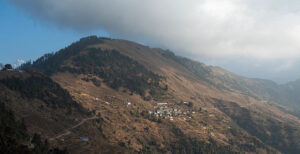
Samzun, Senga and their family live in a remote, hilly region in the Himalayan foothills. Almost everything is far away. They attend church in the town pictured, which is about two hours away from them.

Even after chilling winter nights, Samzun and Senga must get up and tend their livestock. Here, Senga feeds and waters their buffalos.
Bitter nights are one of the hardest aspects of winter for Samzun and his family. After their home was destroyed in a devasting 2015 earthquake and their community faced grave economic difficulties, the family only managed to rebuild a shack of bamboo thatch, tin sheets and wood planks. Winter winds slip through any cracks in the structure, so the family must bundle up with as many blankets as possible, sometimes three or four. In the morning, as the frost melts, water drips into the house, creating additional problems.
For Samzun, Senga, their children and their baby grandson, this means exposure to cold and damp for several months of the year, which can put their health at risk. Though scientists often disagree about why some places experience an increase in deaths during cold-weather months, they agree that inadequate heat indoors increases people’s mortality risk during cold weather. According to the Max Planck Institute for Demographic Research, “If there is any agreement at all in the literature on seasonal mortality, it is the positive impact of a warm indoor climate in connection with central heating and a high standard in the quality of housing.”
Samzun remembers nights when his children cried because they were so cold. Samzun and Senga had to cover them with whatever blankets or clothes they could manage. Then they would light a fire in the kitchen and gather around it. But the disruptions and discomfort during the night made sleep difficult.
No matter how hard the night was, the next morning the family still had to get up and complete tasks necessary for survival. They had to melt water for drinking, bathing, brushing teeth and watering their livestock, and they needed to feed their animals. Then they might need to venture into the cold for more chores or work.
But it wasn’t just the cold that made life hard in winter—it was the distance. In Samzun and Senga’s village, everything seemed far away. There was no school in the village, so his kids had to walk 2.5 hours to get to school. (In fact, they usually boarded in the town where they attended school to avoid hiking five hours a day.) There was no church in the village either, so Samzun and his family trekked about two hours to attend church in a nearby village. Even the nearest market required a few hours’ journey. If they ran out of food or supplies, they had to walk hours in the cold, often on slushy ground without adequate shoes. Many farmers had to walk a distance to their own farmland since flat land was limited.
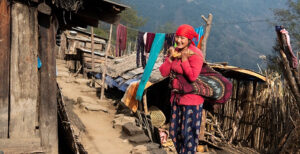
The difficult climate and limited opportunities in Samzun’s village make it challenging to provide for a family. His daughter Rael lives with him because her husband works abroad.
Earning enough income to build a better home, or even to buy enough blankets, also seemed far away. Samzun’s family made their living farming potatoes, corn and wheat. But this high-elevation region was difficult terrain for agriculture. And if snow delayed them from planting their crops even for a few weeks, they wouldn’t reap a good harvest. They also kept a few livestock—a cow, a pair of bullocks, a water buffalo and some goats—to provide for their needs. Yet they still earned only a meager income, so Samzun couldn’t afford to purchase enough blankets for his family to stay warm.
But Samzun and his family knew a God who came near—a God who left heaven and dwelled among His own creation. Was He with them even in the wintertime, when the distance to perform basic life activities seemed unbearable?
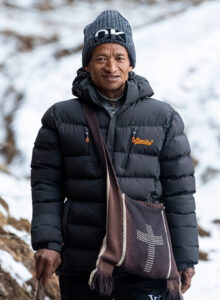
Pastor Kees knows what it’s like to endure winter’s cold, but he is determined to share Christ’s love despite the challenges.
Samzun and his family weren’t alone in their struggles. They belonged to a church, led by GFA pastor Kees, in a nearby village.
Pastor Kees and his family could identify with the struggles Samzun’s family endured. Like Samzun, the pastor had children who needed to stay warm during the cold. He, too, lived in a house made of stone, dirt and wood planks that was often battered by winter winds.
“Because of the cold wind, cold air, the entire area gets very cold during morning time,” Pastor Kees says. “You don’t feel like leaving the bed because it’s too cold. Somehow, when we manage to get up from the bed, we immediately rush to the kitchen, and we sit around the fire just to warm ourselves up. … Unless we heat water, we cannot even wash our faces or brush our teeth. It’s that cold here, and living in this place is quite challenging and quite difficult during winter, I must say.”
Pastor Kees, his wife and his children all suffer from health issues if they brave the cold without proper gear. His wife, who injured her leg in the 2015 earthquake, feels pain during the cold weather. Sometimes their children get sick with coughs or colds. For Pastor Kees, frigid, sunless weather makes it painful to walk to villages one, two or even three hours away to do ministry. His family occasionally comments that it would be nice if they lived in a place less cold.
“But then we have come here for ministry,” Pastor Kees explains. “We have come here to share the Gospel to the people of this village. … So this is my commitment: that no matter how cold it gets, though we physically feel very difficult during winter, we are here serving the Lord.”
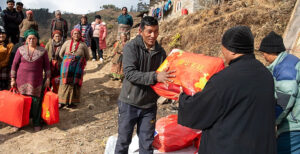
Samzun rejoiced to be one of 30 people to receive a warm, cozy blanket.
Knowing firsthand the challenges of living in this chilly, high-elevation area, Pastor Kees worked with other GFA pastors and leaders to provide a solution for people in his community—in fact, 30 solutions, carried by SUV from a market more than six hours away.
Samzun trekked 2 hours with anticipation. Perhaps the distance didn’t seem far that day because he had heard the church would be giving him a useful gift. The crowd watched in excitement as he and 30 other families received blankets, solutions to help protect them from the cold. A smile brightened Samzun’s face as he picked up the thick, plush blanket.
“This [blanket] is going to keep me and my family very warm and cozy,” Samzun said, “even during the coldest night. … This blanket is going to be a great blessing to my family—especially the small ones, my grandchild.”
Samzun thanks God and the church for providing a gift that will help protect his family at night and give them better sleep. For Samzun, the blanket is one step toward enjoying mornings with a little more energy, ready to do the work he must do to care for his family, with faith in the God who can conquer any distance to take care of His children.
Pastor Kees and his family also received a blanket and some winter clothing so they, too, can stay warm and healthy for the ministry God has given them. Not only in his nation but around the world, cold temperatures make people’s lives difficult—and sometimes take lives. Even in regions that don’t experience harsh winters, moderate drops in temperature can cause cardiovascular and respiratory stress and inflammation, putting people at risk of health complications or death.
But God has planted GFA missionaries like Pastor Kees in these communities. They know the hardships of living in the cold; they also know the faithfulness of God, and they share His compassion with the people they serve.
“We do suffer from cold, and sometimes that discourages me … but I strengthen myself, and I think I should continue to serve the Lord no matter how cold it gets during winter.”
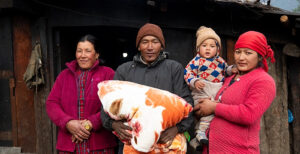
Samzun and his family are grateful for the gift of a blanket—a gift that will help them stay warm and sleep better.
“We do suffer from cold, and sometimes that discourages me,” remarks Pastor Kees. “But at the same time, I lift up my spirit by thinking that Jesus died for me, who suffered much more than I can imagine or I can go through. So, when I think that Jesus can suffer for me and my family and my children, then why not bear this much cold and serve the Lord here in this cold place? So this kind of discouragement doesn’t last long, but I strengthen myself, and I think I should continue to serve the Lord no matter how cold it gets during winter.”
Pastor Kees and other GFA missionaries not only tell people about the love of Christ, the God who suffered and died for them, but they also exemplify this love by working to meet the needs of their communities. In places where people struggle to keep warm, that love often takes the shape of thick, fuzzy blankets that help protect people’s health.
“I know that there are many places even colder than this, in higher altitudes, where people also need blankets,” Samzun says. “It would be good to give them also.”
There are still many people in need. You can be the turning point in a family’s life, allowing them to stay warm, sleep well, and even survive during harsh winters. With your help, GFA missionaries can give the gift of winter clothing and blankets to show people like Samzun and his family that God is near, and He cares about their every need.
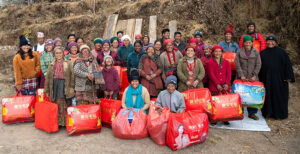
Through the generosity of GFA partners, missionaries like Pastor Kees can work to meet the needs of their communities, including the need for warmth. These 30 individuals received blankets for their families, but many more people need these vital gifts.
There are many ways you can fundraise, whether it’s a bake sale, a marathon, or a party!